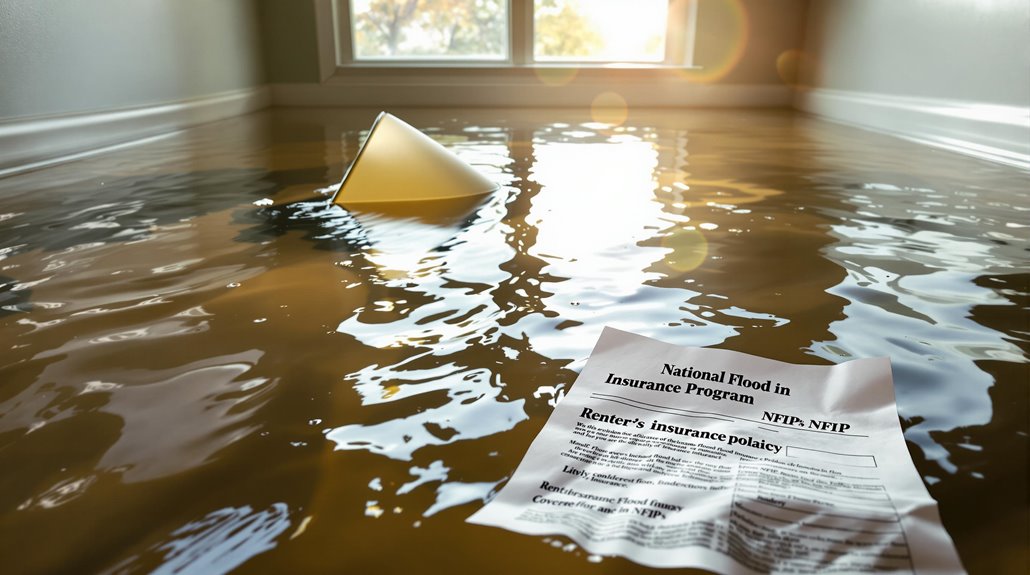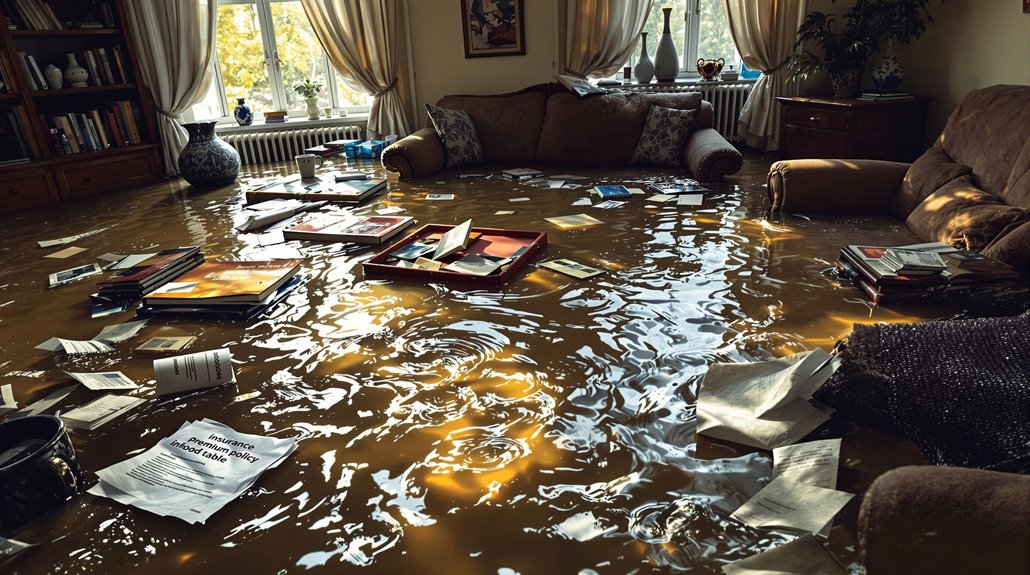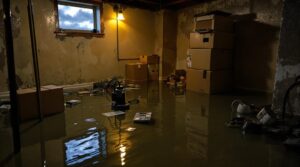Renters insurance policies typically exclude flood damage coverage, leaving renters vulnerable to financial losses resulting from flooding. Standard policies do not cover damage to personal property due to flood, nor do they cover damage to the physical structure of rental properties. Understanding these exclusions is essential for renters to make informed coverage decisions and guarantee adequate protection. Exploring additional flood insurance options and understanding the associated costs can help renters safeguard their personal belongings and mitigate potential financial burdens.
Key Takeaways
- Standard renters insurance policies typically exclude flood damage coverage, leaving renters vulnerable to financial losses from flood-related damage.
- Renters insurance does not cover damage to personal property due to flooding, which can lead to substantial financial burdens for renters.
- Separate flood insurance is necessary to cover personal property losses due to flooding, even in low to moderate flood risk areas.
- The National Flood Insurance Program (NFIP) and private insurers offer flood insurance options, with coverage managed by FEMA to mitigate flood damage.
- Review of flood insurance policy details is crucial for understanding coverage limits and associated costs, including premium rates and deductibles.
Understanding Renters Insurance Coverage & Flooding
Standard renters insurance policies typically have limitations that exclude coverage for flood damage to personal property, leaving renters vulnerable to significant financial losses in the event of a flood.
To guarantee protection for their belongings, renters must consider separate flood insurance options that can provide coverage for items such as clothing, electronics, and furniture.
Understanding the limitations of standard policies and exploring available flood insurance options is essential for renters to make informed decisions about their coverage.
Standard Policy Limitations
The domain of renters insurance is often shrouded in misconceptions, particularly when it comes to coverage for flood damage.
Standard renters insurance policies typically exclude flood-related losses, meaning that renters are not protected against damage to their personal property in the event of a flood.
To obtain flood damage coverage, renters must purchase separate flood insurance, which is available through the National Flood Insurance Program and private insurers.
This additional coverage can provide financial protection for personal items such as clothing, electronics, and furniture.
It is crucial for renters to understand the limitations of their standard renters insurance and consider supplemental flood insurance to guarantee thorough personal property coverage.
Personal Property Protection
Beyond the limitations of standard renters insurance policies, securing protection for personal property against flood-related losses is a fundamental concern for renters. Renters insurance does not cover flood damage to personal property, leaving individuals vulnerable to significant replacement costs in the event of a flood.
To mitigate this risk, renters can consider purchasing a separate flood insurance policy. This coverage is particularly vital for those residing in flood-prone areas, where premiums may be higher due to increased risk.
- A flood can destroy priceless family heirlooms and irreplaceable belongings.
- The financial burden of replacing essential items, such as clothing and electronics, can be overwhelming.
- Loss of personal property can have a profound emotional impact, affecting overall well-being.
- A flood insurance policy can provide peace of mind and protect against unforeseen losses.
Flood Insurance Options
While renters insurance provides essential protection against various types of losses, such as theft and fire, flood-related losses are excluded from standard policies. This makes it crucial for renters to explore separate flood insurance options.
Flood insurance is available in over 23,000 communities participating in the National Flood Insurance Program, offering coverage managed by FEMA. This separate flood insurance policy provides flood coverage for personal property, helping renters protect against flood-related losses.
Coverage limits and costs vary based on factors such as location and proximity to flood-prone areas. Renters should review their flood insurance policy to understand specific coverage details and limitations, as not all items may be covered.
Property insurance deductibles must be met before any flood damage benefits become available to renters.
A renters insurance policy with added flood insurance guarantees thorough protection for belongings.
Exclusions In Standard Renters Insurance Policies
Because standard renters insurance policies do not provide extensive coverage for all types of damage, it is essential for renters to understand what is excluded from their policies.
Standard policies typically exclude flood damage to personal property. To understand these exclusions, consider the following:
- Flooding from external sources, such as heavy rain or rising water, is explicitly excluded from standard renters insurance policies, highlighting a need for separate flood insurance.
- Damage caused by sewer backups or sump pump failures is typically not included unless additional coverage is purchased.
- Renters insurance does not provide coverage for damage to the physical structure of the rental property.
- Personal property losses resulting from flooding, such as clothing and furniture, are not compensated under standard renters insurance policies.
Does Renters Insurance Cover Flood Damage To Personal Property?

Floods can have a devastating impact on personal property, resulting in common damages such as water-soaked furniture, ruined electronics, and destroyed clothing.
Replacing lost belongings can be a significant financial burden for renters, making it essential to take into account the potential costs of flood damage.
The financial impact of floods on personal property can be substantial, underscoring the importance of understanding the extent of coverage provided by renters insurance policies.
The Impact Of Floods On Personal Property
Personal property is a significant investment for most renters, comprising essential items such as clothing, electronics, and furniture that can be difficult to replace in the event of loss or damage.
Standard renters insurance does not cover flood damage to personal property, leaving renters vulnerable to significant financial losses. To mitigate this risk, renters can consider purchasing separate flood insurance, which can provide coverage for personal belongings.
- A family's cherished photo albums and irreplaceable heirlooms destroyed by floodwaters
- A student's laptop and textbooks ruined, disrupting their academic pursuits
- A professional's essential work equipment and tools lost, impacting their livelihood
- A family's comfort and sense of security compromised by the loss of their personal possessions
It is crucial for renters to understand the exclusions in a flood insurance policy to guarantee adequate coverage.
Common Flood-Related Damages
The types of flood-related damage renters may experience can vary considerably. Typically, standard renters insurance policies exclude coverage for flood damage to personal property, requiring separate flood insurance for protection. This exclusion applies to damage caused by flooding from external sources, such as heavy rains or rising water levels.
Flood insurance, available in NFIP-participating communities, can provide coverage for personal belongings, including furniture, electronics, and clothing. However, policy limits and conditions may apply.
Despite their location, renters should assess their flood risk and consider obtaining flood insurance to safeguard their personal property against unforeseen flood-related losses, as even those in low-risk areas can be vulnerable due to proximity to water bodies.
Separate flood insurance guarantees coverage against such flood damage.
Replacing Lost Belongings
Because standard renters insurance policies typically exclude flood damage, renters may find themselves facing significant financial burdens to replace belongings lost or damaged in a flood.
To mitigate this risk, renters can consider purchasing separate flood insurance, which can provide coverage for personal property up to the policy's coverage limits.
- Lost family heirlooms, such as antique furniture or jewelry, may be irreplaceable.
- Essential items, like clothing and electronics, can be costly to replace.
- Important documents, such as identification and medical records, may be difficult to recover.
- Cherished memories, like photos and mementos, can be lost forever.
Financial Impact Considerations
Unless renters have taken steps to secure dedicated flood insurance, those whose personal property is damaged or lost in a flood may find themselves confronting considerable financial burdens. The financial impact of a flood can be substantial, with costs extending beyond the value of lost belongings to include temporary housing, food, and other living expenses.
| Flood Insurance Considerations | Financial Implications |
|---|---|
| No flood insurance | Total loss of personal property |
| With flood insurance | Coverage for loss of personal property |
| Low to moderate flood risk | Lower premiums |
| High flood risk | Higher premiums |
| Separate flood policy required | Additional premiums |
Evaluating The Need For Additional Flood Insurance
How susceptible are renters to the financial consequences of flood damage, and what steps can be taken to mitigate these risks? As standard renters insurance policies do not cover flood damage, renters must consider separate flood insurance. This additional coverage is available in many NFIP-participating communities and through private insurers, providing protection for personal items in case of flooding.
Key considerations for evaluating flood insurance needs include:
- Renters in flood-prone areas, including those near bodies of water, should prioritize additional coverage.
- Location plays a significant role in determining premiums for flood insurance.
- Personal property like clothing and furniture can be covered by flood insurance.
- Checking eligibility for the National Flood Insurance Program (NFIP) is essential, as it offers coverage to renters in over 23,000 communities.
The Role Of The National Flood Insurance Program (NFIP)

The National Flood Insurance Program (NFIP) plays an essential role in providing flood insurance coverage to renters, property owners, and businesses in participating communities across the United States.
Managed by FEMA, the NFIP offers flood insurance to mitigate the financial impact of flood damage. Over 23,000 communities participate in the program, which requires them to implement regulations aimed at reducing flood risks.
NFIP flood insurance policies typically cover damage to personal property, making it a vital supplement to standard renters insurance policies. Coverage options and premium costs vary based on factors such as location, flood risk, and coverage limits.
Options For Purchasing Flood Insurance
While standard renters insurance policies typically exclude flood-related losses, renters can explore alternative options to protect their personal belongings from flood damage.
To mitigate the risk of flooding, renters can purchase flood insurance through the National Flood Insurance Program (NFIP) or private insurers. Before obtaining flood insurance, renters must assess their risk of flooding, taking into account factors such as location and proximity to bodies of water.
- Consider the devastating financial impact of losing personal belongings in a flood, with no means to replace them.
- Think about the stress and emotional toll of dealing with flood damage, and the importance of having a safety net.
- Weigh the cost of flood insurance against the potential losses, considering coverage limits and policy exclusions.
- Recognize the importance of reviewing policy terms to guarantee adequate protection.
Cost Considerations For Flood Insurance

When evaluating the cost of flood insurance, determining premium rates is a vital consideration, as rates can vary markedly based on factors such as location, coverage limits, and risk factors.
Evaluating coverage options is also essential, as renters must weigh the level of coverage needed against the associated costs, considering the value of their personal property and the potential financial impact of a flood.
Analyzing the impact of deductibles on overall costs is another key consideration, as higher deductibles may lower premium rates but increase out-of-pocket expenses in the event of a claim.
Determining Premium Rates
As location plays an essential role in determining flood insurance premiums, renters in areas prone to frequent flooding can expect to pay notably higher rates. The National Flood Insurance Program (NFIP) sets rates based on the property's flood risk, with average annual premiums ranging from $500 to $1,500. However, costs can be higher in high-risk areas.
Renters should consider the following factors that can impact their premium rates:
- Proximity to flood zones, which can greatly increase premium costs
- Elevation of the rental property, with lower-lying areas facing higher rates
- Value of personal property to be insured, as additional coverage limits can increase premiums
- Availability of discounts for communities with adopted floodplain management practices, which can help reduce overall costs.
Evaluating Coverage Options
Because the cost of flood insurance for renters can vary greatly based on several key factors, including coverage limits, property location, and flood risk, it is essential to carefully evaluate coverage options to guarantee adequate financial protection.
The National Flood Insurance Program provides standardized rates, while private insurers may offer different pricing structures that could be more competitive in certain markets.
To make informed decisions, renters should thoroughly review the specific coverage options and exclusions in a flood insurance policy. This analysis will not only impact the overall cost but also the financial protection available in the event of a flood.
Assessing Deductible Impact
While evaluating the cost of flood insurance, the deductible is a significant factor that renters must carefully consider. A higher deductible may lower the monthly premium, but it increases the financial burden during a claim.
Renters should balance premium costs with potential out-of-pocket expenses to guarantee adequate protection without unexpected costs.
- The financial strain of paying a high deductible upfront can be overwhelming.
- A lower deductible provides greater peace of mind, but at a higher monthly premium.
- Renters must carefully review their financial situation to determine the most suitable deductible.
- Failure to understand the deductible's impact on coverage can lead to unanticipated expenses, exacerbating the stress of a flood-related loss.
Tips For Protecting Personal Belongings From Flood Damage
How can renters safeguard their personal belongings from the devastating effects of flood damage? To minimize losses, renters should consider the following measures to protect against water damage. Store valuable items in waterproof containers or elevated locations and regularly check and maintain plumbing systems to prevent leaks and overflows.
| Protection Method | Description | Benefits |
|---|---|---|
| Waterproof Containers | Store valuable items, such as electronics and documents | Minimize water damage to personal belongings |
| Elevated Locations | Store items above flood levels | Reduce risk of water damage |
| Regular Maintenance | Check and maintain plumbing systems | Prevent leaks and overflows |
| Flood-Resistant Barriers | Utilize sandbags or flood shields | Mitigate water intrusion |
| Flood Insurance | Purchase separate flood insurance | Guarantee coverage for personal items in case of flooding |
How To File A Claim For Flood-Related Losses

When filing a claim for flood-related losses, it is vital to document damages thoroughly, including taking photos and creating a detailed inventory of lost or damaged items.
The next step is to contact the insurance provider as soon as possible to report the loss and initiate the claims process.
Understanding coverage limitations, including policy deductibles and coverage limits, is also essential to guarantee a smooth and successful claims process.
Document Damages Thoroughly
In the aftermath of a flood, a thorough documentation of damages is essential for renters seeking to recover losses. Documenting all damages to personal property thoroughly with photographs or videos is vital in supporting a claim for losses. This documentation should capture the extent of the damage, as it will serve as the basis for any insurance claim submitted.
Some key points to focus on when documenting damages include:
- Confirming all images or videos are clear and dated
- Documenting the make, model, and purchase date of damaged items when possible
- Including receipts or appraisals to demonstrate item values
- Maintaining an accurate inventory of damaged items to guarantee extensive coverage of losses
Contact Insurance Provider
Following a flood, renters must promptly contact their insurance provider to initiate the claims process for flood-related losses.
It is important to confirm coverage details, as standard renters insurance typically does not cover flood damage. If a separate flood insurance policy is in place, renters should follow the specific claims process outlined by that insurer, which may differ from standard renters insurance procedures.
When contacting the insurance provider, renters should be prepared to provide documentation of the damage, such as photographs and receipts for affected items.
Keeping a record of all communications with the insurance provider, including dates, times, and names of representatives spoken to, is also essential for a smooth claims process.
Understand Coverage Limitations
Renters successfully initiating the claims process with their insurance provider is merely the first step in recovering from flood-related losses.
It is essential to understand the coverage limitations of their flood insurance policy, as not all personal items may be covered and exclusions apply. Renters insurance typically does not cover flood-related damage to personal property, necessitating a separate flood insurance policy for protection against such losses.
- The cost of temporary housing due to flooding is generally not covered by flood insurance.
- Certain personal items, such as valuable artwork or jewelry, may require additional coverage.
- Flood insurance policies often have limits on coverage for specific items, such as electronics or clothing.
- Exclusions may apply for damage caused by sewer backup or sump pump failure.
Seek Professional Assistance From A Public Adjuster
Filing a claim for flood-related losses can be a complex and time-consuming process, often requiring a thorough understanding of the insurance policy and its terms.
A public adjuster can provide invaluable assistance in evaluating damage, documenting losses, and guaranteeing a fair settlement from the flood insurance policy. Working on behalf of the policyholder, a public adjuster navigates the claims process to maximize compensation.
Their fee, typically a percentage of the settlement amount, is generally between 5% and 15%. A public adjuster can also guide policyholders on necessary documentation, such as photos and repair estimates, to support the claim effectively.
Studies have shown that claims handled by public insurance adjusters can result in settlements up to 500% higher for non-catastrophe incidents.
Common Misconceptions About Renters Insurance & Floods
Although renters insurance provides essential protection for personal property, many policyholders harbor misconceptions about the scope of their coverage, particularly when it comes to flood damage.
Standard renters insurance policies typically exclude flooding as a covered peril, leaving renters vulnerable to significant financial losses in the event of a flood.
- Believing that renters insurance automatically covers flood damage, only to discover it's excluded from standard policies.
- Assuming sewer backups and sump pump failures are covered, when in fact they require specific additions to the policy.
- Overlooking the need for a separate flood insurance policy, even in low-risk areas.
- Failing to understand that flood insurance only protects personal property, not the rental structure itself, which remains the landlord's responsibility.







